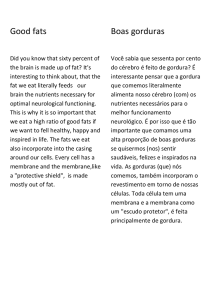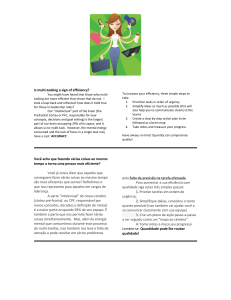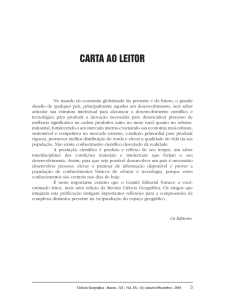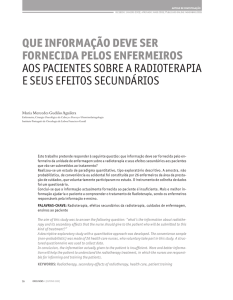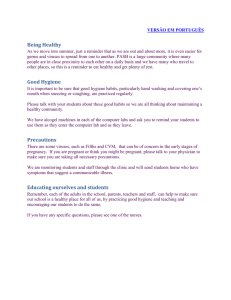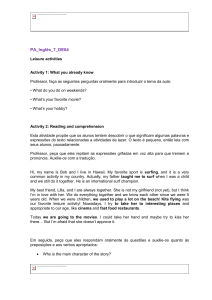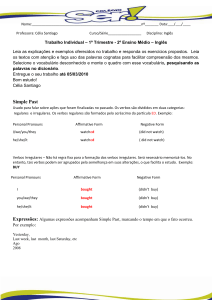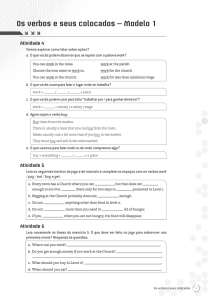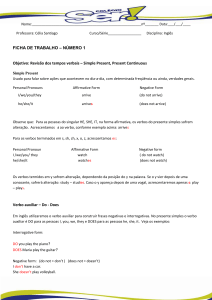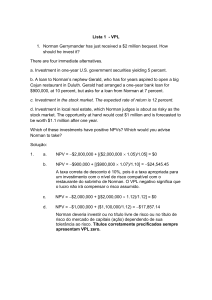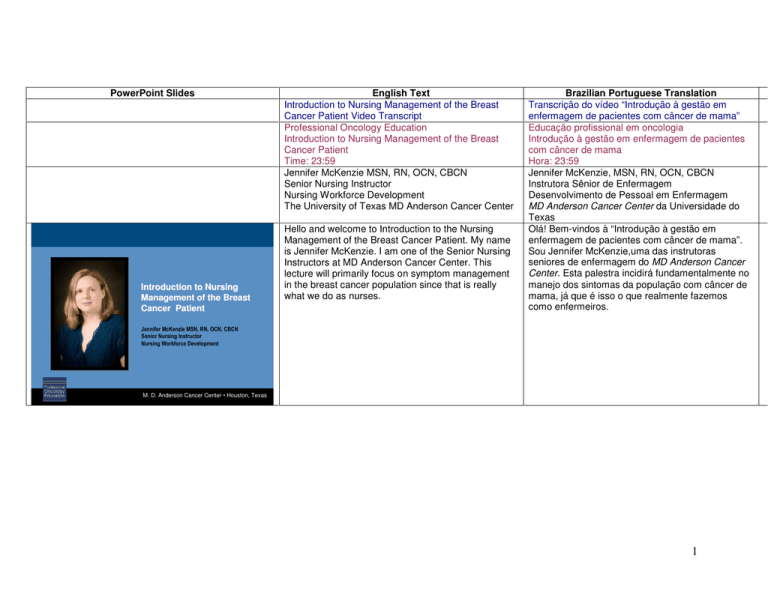
PowerPoint Slides
Introduction to Nursing Management
of the Breast Cancer Patient
Introduction to Nursing
Management of the Breast
Cancer Patient
English Text
Introduction to Nursing Management of the Breast
Cancer Patient Video Transcript
Professional Oncology Education
Introduction to Nursing Management of the Breast
Cancer Patient
Time: 23:59
Jennifer McKenzie MSN, RN, OCN, CBCN
Senior Nursing Instructor
Nursing Workforce Development
The University of Texas MD Anderson Cancer Center
Hello and welcome to Introduction to the Nursing
Management of the Breast Cancer Patient. My name
is Jennifer McKenzie. I am one of the Senior Nursing
Instructors at MD Anderson Cancer Center. This
lecture will primarily focus on symptom management
in the breast cancer population since that is really
what we do as nurses.
Brazilian Portuguese Translation
Transcrição do vídeo “Introdução à gestão em
enfermagem de pacientes com câncer de mama”
Educação profissional em oncologia
Introdução à gestão em enfermagem de pacientes
com câncer de mama
Hora: 23:59
Jennifer McKenzie, MSN, RN, OCN, CBCN
Instrutora Sênior de Enfermagem
Desenvolvimento de Pessoal em Enfermagem
MD Anderson Cancer Center da Universidade do
Texas
Olá! Bem-vindos à “Introdução à gestão em
enfermagem de pacientes com câncer de mama”.
Sou Jennifer McKenzie,uma das instrutoras
seniores de enfermagem do MD Anderson Cancer
Center. Esta palestra incidirá fundamentalmente no
manejo dos sintomas da população com câncer de
mama, já que é isso o que realmente fazemos
como enfermeiros.
Jennifer McKenzie MSN, RN, OCN, CBCN
Senior Nursing Instructor
Nursing Workforce Development
M. D. Anderson Cancer Center • Houston, Texas
1
Introduction to Nursing Management
of the Breast Cancer Patient
Objectives
So, our objectives for this presentation will be to
identify common symptoms experienced in the breast
cancer patient and then to discuss the management
and nursing implications of those symptoms.
Nossos objetivos para esta apresentação serão o
de identificar os sintomas comuns experimentados
pela paciente com câncer de mama e, depois,
discutir a gestão e as consequências desses
sintomas para a enfermagem.
The topics that we are going to cover will be: pain,
lymphedema, chemotherapy-induced nausea and
vomiting, fatigue, cognitive dysfunction, hot flashes,
and osteoporosis.
Os assuntos que abordaremos são: dor, linfedema,
náusea e vômito provocados pela quimioterapia,
fadiga, disfunção cognitiva, ondas de calor e
osteoporose.
• Identify common symptoms experienced by
patients with breast cancer
• Describe the management and nursing
implications of common symptoms
Introduction to Nursing Management
of the Breast Cancer Patient
Symptom Management in Breast Cancer
• Pain
• Lymphedema
• Chemotherapy Induced Nausea and Vomiting
• Fatigue
• Cognitive Dysfunction
• Hot Flashes
• Osteoporosis
2
Introduction to Nursing Management
of the Breast Cancer Patient
Pain
Post-mastectomy Pain
• Tightness, tenderness, nerve pain
• Increased risk with mastectomy vs lumpectomy
Cancer Pain
• Bone pain
Neuropathic Pain
• Associated with taxanes
Introduction to Nursing Management
of the Breast Cancer Patient
Pain
Post- mastectomy pain
Interventions
• NSAIDs
• COX-2 Inhibitors
• Tricyclic antidepressants
• Anticonvulsants
• Limiting movement
• Heat/ ice
(not recommended if risk for lymphedema)
First, we will talk about pain a little bit. There are
several different types of pain that patients may
experience after breast cancer treatment. The first is
postmastectomy pain. There is a term called
postmastectomy pain syndrome which may be
characterized by tightness, maybe some burning in
the chest area, tenderness and nerve pain. This may
last months to years after a mastectomy. It tends to be
an increased risk with a mastectomy versus a
lumpectomy. We will also talk about cancer pain,
primarily bone pain. One of the most common areas
that breast cancer metastasizes to is the bone. So,
the majority of cancer pain experienced with breast
cancer patients will be bone pain. And then, we will
also talk a little bit about neuropathic pain. One of the
primary treatments for breast cancer are the taxanes:
Taxotere and paclitaxel. And those are associated
with neuropathy and patients often experience
neuropathic pain following those treatments.
For the postmastectomy pain, several interventions
may be recommended. NSAIDs may be helpful as
well as COX-2 inhibitors. For the nerve pain, you may
see tricyclic antidepressants used, as well as some of
the anticonvulsants. There is some information that
limiting movement may help some of the pain in the
mastectomy area, but we need to be a little bit careful
about that because decreased movement may set
them up for immobility problems later on and maybe a
little bit more lymphedema. So that issue is maybe a
little bit controversial. Heat or ice may be helpful at the
incision site, but, if the patient is at risk for
lymphedema, that can worsen the lymphedema. So
we need to be a little careful with that one as well.
Primeiro, falaremos um pouco sobre a dor. Depois
do tratamento de câncer de mama, as pacientes
sentem diversos tipos de dor. O primeiro [tipo] é a
dor de pós-mastectomia. Há uma expressão
denominada “síndrome dolorosa pós-mastectomia”,
que pode ser caracterizada por opressão, talvez
certa queimação no peito, sensibilidade tátil e
neuralgia. Isso pode durar por meses e até anos
depois da mastectomia. Costuma haver um maior
risco na mastectomia do que na nodulectomia.
Também falaremos sobre a dor oncológica,
principalmente a dor óssea. O osso é um dos locais
mais comuns de metástase do câncer de mama.
Então, a maioria da dor oncológica sentida pelas
pacientes com câncer de mama será a dor óssea.
Por isso, também falaremos um pouco sobre a dor
neuropática. Um dos principais tratamentos para o
câncer de mama são os taxanos. Taxotere e
paclitaxel. Eles estão associados à neuropatia, e as
pacientes frequentemente sentem dor neuropática
depois desses tratamentos.
Para a dor pós-mastectomia são recomendadas
várias intervenções. Os AINEs podem ser
benéficos, assim também como os inibidores de
COX-2. Para a neuralgia, vocês veem que são
utilizados os antidepressivos tricíclicos, bem como
alguns anticonvulsivantes. Existe alguma
informação [indicando] que restringir o movimento
pode ajudar de alguma forma a [aliviar] a dor na
região da mastectomia, mas temos que ter um
pouco de cuidado com isso porque a redução de
movimentos poderia ocasionar problemas de
imobilidade e, talvez, um pouco mais de linfedema.
Então, talvez, esse assunto seja um pouco
polêmico. Calor ou gelo na região da incisão pode
ajudar, mas se a paciente estiver em risco para
linfedema, esta poderá ser agravada. Então, temos
3
Introduction to Nursing Management
of the Breast Cancer Patient
Pain
Cancer Pain
Bone Pain
– Interventions
• Opioids
– Long acting around the clock
– Break through- immediate release opioids
For the bone pain, the primary interventions that you
will see are opioids. With most pain management, you
will see long-acting opioids as well as breakthrough
pain management. So usually you will see some
immediate release opioids in combination with your
long-acting opioids. Methadone may also be a good
treatment for cancer pain, also, NSAIDs and
acetaminophen. You will also see bisphosphonates
used for bone metastasis and that may help the
cancer pain as well.
• Methadone
• NSAIDS, Acetominophen
• Bisphosphonates
Introduction to Nursing Management
of the Breast Cancer Patient
Pain
Neuropathic Pain
Interventions
• Tricyclic antidepressants,
• SSRIs
• SNRIs
• Anticonvulsants
• Gabapentin, pregabalin
• Tramadol
• Opioids
For the neuropathic pain, it is essentially the same if it
is nerve pain from the mastectomy or nerve pain from
taxanes. You will see tricyclic antidepressants used,
as well as your serotonin reuptake inhibitors, also,
your serotonin and norepinephrine reuptake inhibitors,
anticonvulsants. You may see gabapentin or
pregabalin, tramadol or opioids. So, most of the
interventions for neuropathic pain will be primarily
pharmacologic.
que ser um pouco cuidadosos com isso também.
Para a dor óssea, as intervenções primárias que
vocês verão são os opiáceos. Na maioria dos
tratamentos da dor vocês verão os opiáceos de
longa duração, bem como tratamentos da dor
incidental ("breakthrough pain”). Geralmente, vocês
verão alguns opiáceos de liberação imediata
combinados com opiáceos de ação prolongada. A
metadona também pode ser um bom tratamento
para a dor oncológica, também os AINEs e o
acetaminofeno. Além disso, vocês verão os
bifosfonatos utilizados para metástase óssea, que
também podem aliviar a dor oncológica.
Para a dor neuropática, é basicamente o mesmo
que para a neuralgia originada pela mastectomia ou
pelos taxanos. Vocês verão que os antidepressivos
tricíclicos utilizados, bem como os inibidores de
recaptação da serotonina, também, os inibidores de
recaptação da serotonina e da norepinefrina,
anticonvulsivantes. Vocês podem ver gabapentina
ou pregabalina, tramadol ou opiáceos. Então, a
maioria das intervenções para a dor neuropática
serão principalmente farmacológicas.
4
Introduction to Nursing Management
of the Breast Cancer Patient
Lymphedema
• Approximately 15-28% of breast cancer patients
• Causes of secondary lymphedema:
–
–
–
–
–
Axillary lymph node dissection
Radiation therapy
Trauma
Metastasis to lymph nodes
Infection
Introduction to Nursing Management
of the Breast Cancer Patient
Lymphedema
Assessing for Lymphedema
– Arm circumference (most common)
• Stage 1 : < 3 cm difference between extremities
• Stage 2: 3-5 cm difference between extremities
• Stage 3: > 5 cm difference between extremities
– Bioelectrical Impedance
– Water displacement
– Perometer
The next topic we will talk about is lymphedema.
Lymphedema can be very disruptive to the patient’s
life. Approximately 15% to 28% of breast cancer
patients will experience some degree of lymphedema.
The lymphedema you will see with breast cancer is
really secondary lymphedema, secondary, really to
axillary node dissection. When we remove the lymph
nodes, then that sets the patient up for having
difficulty with drainage of the lymph so you have an
increased likelihood for that. Radiation therapy
following mastectomy may also increase the risk for
lymphedema. Trauma to the area, trauma to the
extremity where the axillary node dissection will also
put them at risk. Metastasis to the lymph nodes can
increase the likelihood of lymphedema and then
infection in the area where the lymph nodes have
been removed.
O próximo assunto do qual iremos falar é o
linfedema. O linfedema pode ser muito prejudicial à
vida da paciente. Aproximadamente 15% a 28%
das pacientes com câncer de mama terão
linfedema em algum grau. O linfedema que vocês
verão com câncer de mama é, na verdade, um
linfedema secundário, realmente, à dissecção do
linfonodo axilar. Quando extirpamos os linfonodos,
predispomos a paciente a uma drenagem mais
difícil da linfa, então há uma maior probabilidade de
que isso ocorra. A radioterapia após a mastectomia
também pode aumentar o risco para linfedema. O
traumatismo da região, o traumatismo do membro
onde [foi realizada] a dissecção do linfonodo axilar
também as porá em risco. A metástase dos
linfonodos pode aumentar a probabilidade de
linfedema e, depois, de infecção na região de
extirpação dos linfonodos.
When we are assessing for lymphedema, when you
think about lymphedema treatment and management,
the primary thing you should think about is early
detection. The earlier we can detect it, the better we
can treat it. One of the most common tools for
diagnosing lymphedema is looking at arm
circumference. Stage 1: When there is less than 3 cm.
difference between the extremities, that is considered
stage 1. Stage 2 is considered 3 to 5 cm. difference
between the extremities and then stage 3 is greater
than 5 cm. between the extremities. This is the most
common, it’s not necessarily the best, but it is the
most common tool to determine whether or not
lymphedema is starting. Bioelectrical impedance is
another way of determining whether the patients have
lymphedema. Water displacement is actually one of
the best methods, but not very well utilized. And then
a perometer is another way to measure for
Quando avaliamos o linfedema, quando vocês
pensam sobre tratamento e manejo do linfedema, a
primeira coisa que deveríamos pensar é sobre
detecção precoce. Quanto mais cedo for detectado,
melhor poderemos tratá-lo. Uma das técnicas mais
comuns para diagnosticar o linfedema é medindo o
perímetro braquial. Estágio 1: Quando a diferença
entre os membros for inferior a 3 cm, é considerado
estágio 1. O estágio 2 é considerado quando a
diferença entre as extremidades variar de 3 a 5 cm,
e o estágio 3, quando a diferença entre as
extremidades for superior a 5 cm. Esse é o mais
comum, não necessariamente o melhor, mas é o
método mais comum para determinar o início de
linfedema. A impedância bioelétrica é outra forma
de determinar a presença de linfedema nas
pacientes. O deslocamento de água é, na verdade,
um dos melhores métodos, mas não muito bem
5
lymphedema.
Introduction to Nursing Management
of the Breast Cancer Patient
Lymphedema
Risk factors
–
–
–
–
–
–
–
Obesity
Constriction
Injury/trauma
Lack of exercise
Overuse of extremity
Air travel
Diabetes
The risk factors for development of lymphedema
include obesity; the patients that are more overweight
will have a higher risk of developing lymphedema. Any
constriction in the area, if the patient has a
mastectomy, if they are wearing tight fitting clothes,
that can help precipitate the development of
lymphedema. Injury or trauma to the area, as I said
before, if you have a patient that has needle-sticks on
that area, blood pressure is taken on that side, that
can increase the likelihood that they may develop
lymphedema. Lack of exercise also may increase the
likelihood that they are going to develop lymphedema,
but on the other hand, overuse of the extremity may
also contribute to it. Air travel, we know, is a
predisposing factor. Usually if patients are going to
travel and they are at risk for developing lymphedema
or have a history of lymphedema, we suggest they
use a compression sleeve and, if they have diabetes,
they are going to be at higher risk as well.
utilizado. Outra forma de medir o linfedema é
[utilizando] o perômetro.
Um dos fatores de risco para desenvolver linfedema
é a obesidade; as pacientes com mais sobrepeso
têm maior risco para desenvolverem linfedema.
Qualquer constrição da região, se a paciente tiver
mastectomia, se usar roupas justas, poderá
precipitar o desenvolvimento de linfedema. Uma
lesão ou traumatismo na região, como disse antes,
se vocês tiverem uma paciente com agulhas nessa
região, se a pressão for tirada nesse lado, poderá
aumentar a probabilidade de desenvolver
linfedema. A falta de exercício também pode
aumentar a probabilidade de que venham a
desenvolver linfedema, mas por outro lado, o uso
excessivo do membro também pode ser outro fator
contribuinte. Sabemos que as viagens aéreas são
um fator predisponente. Em geral, se as pacientes
vão viajar e estão em risco para desenvolver
linfedema ou têm histórico de linfedema, sugerimos
que usem luva compressora e, caso tenham
diabetes, também estarão em alto risco.
6
Introduction to Nursing Management
of the Breast Cancer Patient
Lymphedema
Treatment
–
–
–
–
–
Complete Decongestive Therapy
Compression Bandaging
Maintaining optimal weight
Manual lymph drainage
Skin care
The treatment for lymphedema is involved in several
different areas. Complete decongestive therapy is the
primary and best treatment for lymphedema. That is
going to include manual lymphatic drainage, use of
compression devices, arm exercises and skin care.
decongestive therapy really should be done by a
licensed provider, either an occupational therapist or a
physical therapist or a nurse that has specialty training
in the management of lymphedema. Compression
bandaging is another option. Maintaining weight. One
thing that you are going to hear me say throughout
this presentation is exercise, exercise, weight,
nutrition. Really with all symptom management, we
know that exercise is one of the best ways to deal with
it. We talked about manual lymph drainage - and then
meticulous skin care, trying to make sure that the skin
does not have any break down will help with the
lymphedema.
O tratamento para linfedema inclui a participação de
diversos campos de conhecimento. A fisioterapia
descongestiva complexa é o melhor tratamento
para linfedema e o mais importante. Neste
tratamento, incluem-se a drenagem linfática
manual, o uso de aparelhos de compressão,
exercícios com os braços e tratamento da pele. A
fisioterapia descongestiva complexa deve ser
aplicada por um profissional habilitado, quer um
terapeuta ocupacional ou fisioterapeuta ou
enfermeiro com a capacitação especializada em
tratamento de linfedema. Outra opção seria a
bandagem compressiva. Manter o peso. Outra
coisa que vocês vão me ouvir dizer durante esta
apresentação é: exercício, exercício, peso, nutrição.
Realmente, em todo manejo de sintomas, sabemos
que o exercício é uma das melhores formas de
resolvê-lo. Falamos a respeito da drenagem manual
da linfa – e, depois, um cuidado meticuloso da pele,
procurando ter certeza de que a pele não apresenta
nenhuma lesão, isso beneficia [a paciente] com
linfedema.
7
Introduction to Nursing Management
of the Breast Cancer Patient
Chemotherapy induced Nausea and Vomiting (CINV)
Doxorubicin/ Epirubicin and Cyclophosphamide
– Considered highly emetogenic: > 90% will have N/V
• Aprepitant
• + Dexamethasone 12 mg PO or IV days 1 - 4
• + 5-HT3 antagonist : Palonosetron, Dolasetron, or
Ondansetron
• ± Lorazepam
• ± H blocker or proton pump inhibitor
NCCN, 2009, Antiemesis
Next, we will talk about chemotherapy-induced
nausea and vomiting. One of the primary treatments
for breast cancer, as you may have seen in one of the
previous videos, are the combination of either
doxorubicin and Cytotoxan or epirubicin and
Cytotoxan. That combination is considered highly
emetogenic, meaning that greater than 90% of
patients are going to experience nausea and vomiting
with those. So, we would like to be very aggressive
with our antiemetic regimens. The NCCN Guidelines,
that is the National Comprehensive Cancer Network.
Their recommendations are that we really kind of
throw everything that we have at them to prevent
nausea and vomiting. Aprepitant is one of the
antinausea medications that is really kind of first line
for prevention of nausea. Dexamethasone and one of
your serotonin antagonists really should be used in
combination with those patients that are receiving this
combination of chemotherapy. Your physician may
choose to add in lorazepam or one of the proton pump
inhibitors. That may also help with the nausea and
vomiting.
A seguir, falaremos a respeito da náusea e do
vômito provocados pela quimioterapia. Um dos
principais tratamentos contra o câncer de mama,
como talvez vocês tenham visto nos vídeos
anteriores, são uma combinação de doxorrubicina e
citoxano ou epirrubicina e citoxano. Essa
combinação é considerada altamente emetogênica,
o que significa que mais de 90% das pacientes
apresentarão náusea e vômito com esses
fármacos. Por isso, gostaríamos de ser bem
rigorosos com os esquemas antieméticos. As
Diretrizes da NCCN, isto é a Rede Nacional do
Câncer Integral. Basicamente, recomendam que
façamos tudo o que estiver ao nosso alcance para
evitar que essas pacientes tenham náusea e
vômito. O aprepitant é um medicamento contra a
náusea que é verdadeiramente de primeira linha
para a prevenção da náusea. A dexametasona e
um dos antagonistas da serotonina deveriam, na
verdade, ser utilizados em combinação para
aquelas pacientes que recebem essa combinação
quimioterápica. O médico deve escolher entre
incluir lorazepam ou um dos inibidores da bomba de
prótons. Isso também pode controlar a náusea e o
vômito.
8
Introduction to Nursing Management
of the Breast Cancer Patient
CINV
Docetaxel/ Paclitaxel
– Low emetic risk: 10 -30 % frequency
Capecitabine
– Minimal risk: prn anti- emetics recommended
Introduction to Nursing Management
of the Breast Cancer Patient
CINV
Breakthrough N/V
Prochlorperazine
Promethazine
Metoclopramide
Lorazepam
Haloperidol
Ondansetron
Granisetron
Dronabinol
Dexamethasone
Olanzapine
Another combination that is commonly used with your
breast cancer patients, another treatment anyway, is
either Taxotere or docetaxel or paclitaxel. Those are
considered pretty low risk of emetogenesis, so low
risk of nausea and vomiting. About 10 to 30% of
patients experience nausea and vomiting with those.
And usually, it is recommended just p.r.n. antiemetic
therapy. Capecitabine is another treatment that is
pretty common in your metastatic patients. That is an
oral chemotherapy that has a very minimal risk as
well, so once again p.r.n. medication is advised.
Outra combinação comumente utilizada em
pacientes com câncer de mama, outro tratamento, é
o Taxotere (ou docetaxel) ou o paclitaxel. Eles são
considerados de risco bem baixo para
emetogênese, ou seja, baixo risco para náusea e
vômito. Cerca de 10% a 30% das pacientes
apresentam náusea e vômito com eles. E,
geralmente, a terapia antiemética recomendada é
somente conforme a necessidade. A capecitabina é
outro tratamento que é muito comum em pacientes
metastáticas. Essa é uma quimioterapia oral que
tem um risco muito mínimo, então, também neste
caso, aconselha-se o uso de medicação conforme a
necessidade.
The best way to manage nausea is really to have
patients take things around the clock, take their
antiemetics around the clock and then have
medications for breakthrough. There are a wide
variety of breakthrough medications. The main
principle behind the breakthrough medicine is to give
something from a different class than we have given
before for breakthrough medicine.
A melhor maneira de controlar a náusea é
realmente fazer com que as pacientes tomem os
remédios na hora certa, tomar os antieméticos na
hora certa e, depois, administrar medicamentos
para a dor incidental. Existe uma grande variedade
de medicamentos para a dor incidental. A principal
noção por trás dos medicamentos para a dor
incidental é administrar um fármaco que pertença a
uma classe diferente da que fora administrada
antes para a dor incidental.
* Give an additional agents from another drug class prn
9
Introduction to Nursing Management
of the Breast Cancer Patient
CINV
Non- Pharmacologic Approaches for N/V
–
–
–
–
–
–
Acupressure
Acunpuncture
Guided Imagery
Music Therapy
Progressive Muscle Relaxtion
Dietary Interventions
The nonpharmacologic interventions are really what
you can help your patients with. Acupressure is
something that has been tried by patients.
Acupressure wristbands may be effective for some
patients; may not. It is not really a risky intervention to
try. Acupuncture: there is more and more data that
acupuncture is actually becoming successful for the
treatment of nausea and vomiting. Guided imagery
may also be helpful. Relaxation techniques,
progressive muscle relaxation, deep breathing
exercises, music therapy, dietary interventions are
going to be probably one of the best things to help
patients. Your patients may not feel like eating for the
first day or two. That is okay as long as they are
keeping pretty of fluids. Patients will usually do a lot
better if we separate their meals from their fluids,
trying to take fluids throughout the day and not fill up
on fluids whenever it is time to eat. When it comes to
dietary interventions, we also recommend that
patients do not eat their favorite foods during that time
of nausea and vomiting because they may end up
with an aversion to that food. Other dietary
interventions may be that sour foods tend to taste a
little bit better. Cold foods, not extreme temperatures,
either hot or cold, kind of moderate temperature
foods. Some patients have said that they feel a little
bit better with ginger. Those kinds of interventions
may be helpful as well. Carbonated beverages.
As intervenções não farmacológicas são o que
realmente vão ajudar as pacientes. A acupressão é
algo que as pacientes têm procurado fazer. As
pulseiras de acupressão podem dar resultado para
algumas pacientes e para outras, não. Na verdade,
não é uma intervenção que implique risco.
Acupuntura: existem cada vez mais dados
demonstrando que a acupuntura está tendo
sucesso no tratamento de náuseas e vômitos. A
[intervenção] guiada por imagem também pode ser
útil. Técnicas de relaxamento, relaxamento
muscular progressivo, exercícios de respiração
profunda, terapia musical, intervenções dietéticas,
provavelmente, ajudarão muito as pacientes. As
pacientes não vão sentir apetite no primeiro ou no
segundo dia. Isso não tem problema desde que se
mantenham hidratadas. No geral, as pacientes
reagem muito melhor se separarmos as refeições
dos líquidos, tentando tomar os líquidos durante o
dia e não encher-se de líquidos na hora de comer.
Quando se trata de intervenções dietéticas, também
recomendamos que as pacientes não comam os
alimentos favoritos durante aquela hora de náusea
ou vômito porque poderão acabar por ter aversão a
esse alimento. Outras intervenções dietéticas
seriam que os alimentos ácidos costumam ser um
pouco mais saborosos. Alimentos frios, sem
temperaturas extremas, quentes ou frias, tipo assim
como alimentos com temperaturas moderadas.
Algumas pacientes disseram que se sentem um
pouco melhor com gengibre. Esse tipo de
intervenção também pode ser benéfico. Bebidas
com gás.
10
Introduction to Nursing Management
of the Breast Cancer Patient
Cognitive Dysfunction
“Chemo Brain”
– Memory changes
– Information processing speed
– Multi-tasking
Recommendations
–
–
–
–
–
–
Avoid distraction
Practicing activities such as crossword puzzles
Using organizers
Manage stress
Exercise
Sleep hygiene
The next thing that we are going to talk about is
cognitive dysfunction. Several of --- many of your
patients may complain of what we call “chemo brain.”
This is the thing that patients complain of as being the
most disruptive to their lives, the most difficult thing to
deal with. And that is really cognitive dysfunction that
they experience during chemotherapy, during breast
cancer treatment. “Chemo brain” is usually
characterized by memory changes. Patients will also
complain of difficulty with processing information
quickly. It takes them longer to think about things, to
answer questions, to kind of just think through their
daily activities and then they may have difficulty with
multi-tasking. It is very hard to stay focused on
different things. So, the recommendations for “chemo
brain” are really to try to avoid distraction as much as
possible. When you really need to focus, try to
minimize distractions around you. Practicing activities
that kind of keep the mind sharp, like crossword
puzzles, those kinds of things that really kind of keep
your brain active. Patients may need to use
organizers to kind of plan out their activities so they do
not forget about appointments and things that they
need to do. Stress can also really impact your
cognitive function. If patients are under a lot of stress,
they may have more difficulty paying attention to
tasks. So, anyway that we can manage stress.
Exercise: there’s that word again. Exercise may also
help with the cognitive function as well. And then
sleep hygiene: what sleep hygiene is, is really trying to
create activities that help with sleep, meaning that
patients should try to minimize naps. If you take a
nap, take a short nap. Try to sleep at the same time
every night, wake up at the same time every day,
create a routine that creates the most stability. Don’t
drink caffeine near bedtime. Don’t exercise too close
to bedtime. So, if a patient is experiencing insomnia,
O próximo assunto sobre o qual vamos falar é a
disfunção cognitiva. Várias, muitas de suas
pacientes talvez tenham se queixado do que nós
chamamos “chemo brain.” Isto é do que as
pacientes mais se queixam de ser o mais prejudicial
para sua vida, o mais difícil de lidar. E isto é
realmente a disfunção cognitiva que elas
experimentam durante a quimioterapia, durante o
tratamento do câncer de mama. A “Chemo brain” é
geralmente caracterizada por mudanças na
memória. As pacientes também se queixam de ter
dificuldade de processar rapidamente as
informações. Elas levam mais tempo para pensar
sobre coisas, para responder às perguntas, para
simplesmente pensar nas suas atividades diárias e
têm dificuldade em realizar várias tarefas ao mesmo
tempo. É muito difícil manter a atenção em várias
coisas. Por isso, as recomendações para “chemo
brain” são realmente as de evitar o máximo possível
as distrações. Quando você realmente precisa se
concentrar, procure reduzir ao mínimo as distrações
ao seu redor. Praticar atividades, daquelas que
mantêm a mente afiada, como palavras cruzadas,
esse tipo de coisas que realmente mantêm o
cérebro ativo. As pacientes precisam utilizar
agendas para planejar suas atividades, assim elas
não esquecem das consultas e do que precisam
fazer. O estresse também pode afetar muito a
função cognitiva. Se as pacientes estiverem sob
muito estresse, terão mais dificuldade para prestar
atenção nas tarefas. Então, qualquer forma que nos
possibilite controlar o estresse. Exercício: aí está
essa palavra novamente. O exercício também pode
beneficiar a função cognitiva. E, depois, a higiene
do sono: a higiene do sono é procurar criar
atividades que ajudem o sono, isto é, que as
pacientes procurem reduzir as sestas ao mínimo.
11
of course, it is going to impair their cognitive ability as
well.
Introduction to Nursing Management
of the Breast Cancer Patient
Fatigue
Risk Factors
–
–
–
–
Anemia
Chemotherapy
Radiation
Insomnia/ sleep
disturbance
– Stress
– Dehydration
–
–
–
–
–
–
Inactivity
Infection
Pain
Hypoxia
Depression
Poor nutrition
And that leads into fatigue. Fatigue is another
experience that patients complain about quite a bit
during treatment, not only breast cancer patients, but
almost all patients going through cancer treatment. It
is actually the number one symptom experienced by
all cancer patients. Risk factors: pretty much
everything that the patient is going through is going to
contribute to their fatigue. Anemia, either
chemotherapy-induced anemia, anemia related to the
disease. Chemotherapy, in general, may cause
fatigue. The majority of patients getting radiation
therapy will also complain of fatigue. Of course, if they
have insomnia or sleep disturbance, they’ll have more
fatigue. Stress will increase the fatigue. Dehydration,
inactivity, infection. If you’ve ever had the flu, you
know how fatiguing infection can be. If the patient has
persistent pain, they will have more fatigue. Hypoxia,
depression, and poor nutrition all can contribute to
fatigue.
Se tirarem uma soneca, dormir por pouco tempo.
Procurar dormir à mesma hora todas as noites,
acordar à mesma hora todos os dias, criar uma
rotina que produza a maior estabilidade. Não tomar
cafeína à hora de dormir. Então, se uma paciente
sofrer de insônia, claro que esta também
prejudicará sua capacidade cognitiva.
E isso resulta em fadiga. A fadiga é outra
experiência da qual as pacientes se queixam
bastante durante o tratamento, não somente as
pacientes com câncer de mama, mas quase todas
as pacientes que estão em tratamento contra o
câncer. De fato, é o sintoma número um
apresentado por todas as pacientes com câncer.
Fatores de risco: basicamente tudo pelo que a
paciente está passando contribui para a sua fadiga.
Anemia, seja provocada pela quimioterapia, seja
relacionada à doença. Em geral, a quimioterapia
causa fadiga. A maioria das pacientes que recebem
radioterapia também se queixa de fadiga. Claro que
se elas tiverem insônia ou distúrbio do sono,
sentirão mais fadiga. O estresse aumenta a fadiga.
A desidratação, a inatividade e as infecções. Quem
teve uma gripe, sabe da fadiga que as infecções
causam. Se a dor for persistente, a paciente sentirá
mais fadiga. A hipóxia, a depressão e uma nutrição
inadequada podem contribuir para a fadiga.
12
Introduction to Nursing Management
of the Breast Cancer Patient
Fatigue
Interventions
– Treat the underlying cause
• ESA’s, iron supplements, antidepressants
–
–
–
–
–
Exercise
Relaxation
Sleep hygiene
Massage, healing touch
Dietary Interventions
Introduction to Nursing Management
of the Breast Cancer Patient
Hot Flashes
Risk Factors
–
–
–
–
–
–
–
Age
Obesity
African American
Lack of exercise
Ovarian failure secondary to chemotherapy
Hormone Therapy
Smoking
So the major interventions will be to treat the
underlying problem. If they are anemic, then we’ll try
to treat the anemia. If they are -- -if this is related to
depression, then we may put them on
antidepressants. Other interventions that will be
helpful for you to teach the patient will be to, here it is
again, exercise. The more activity they can do, the
more energy they are going to have. Relaxation
techniques, the sleep hygiene that I mentioned before,
massage, healing touch, may also be interventions
that will help fatigue. And then dietary interventions,
making sure that they are eating a nutritious diet,
getting enough protein, getting enough calories, so
that they are not feeling fatigued and making sure that
they are hydrated well enough.
Então, as principais intervenções se referem ao
tratamento do problema subjacente. Se estiverem
anêmicas, procuraremos tratar a anemia. Se
estiverem – se for relacionado à depressão,
daremos antidepressivos. Outras intervenções
benéficas que vocês podem ensinar às pacientes,
vejam aqui de novo, são os exercícios. Quanto mais
atividades fizerem, mais energia terão. As técnicas
de relaxamento, a higiene do sono que já
mencionei, a massagem, o toque terapêutico,
também são intervenções que podem ajudar a
combater a fadiga. E, depois, as intervenções
dietéticas, confirmando que comem uma dieta
nutritiva, que recebem proteína suficiente ,
suficientes calorias, para que não sintam fadiga e
confirmando que estão suficientemente hidratadas.
The next thing that we will talk about is hot flashes.
Many, many of your patients with breast cancer will be
experiencing hot flashes. Of course, the main risk
factor may be age. The closer we are to menopause,
the more hot flashes. Obesity is a risk factor. AfricanAmerican patients tend to have more hot flashes than
other races. Lack of exercise, ovarian failure due to
chemotherapy treatment. Cytoxan is one of the agents
that is commonly given for breast cancer that can
cause sterility. So, they may have decreased ovarian
function due to chemotherapy. The majority of your
hormone therapies will cause hot flashes. Tamoxifen
tends to be one of the agents that causes more hot
flashes. And then smoking will increase the risk for hot
flashes.
O próximo assunto do qual iremos falar são as
ondas de calor. Muitas, muitas das nossas
pacientes com câncer de mama sentirão ondas de
calor. Sem dúvida que o principal fator de risco é a
idade. Quanto mais próximo da menopausa, mais
quentes serão as ondas de calor. A obesidade é um
fator de risco. As pacientes afro-americanas têm
maior probabilidade de sentir mais ondas de calor
que as das demais raças. A falta de exercício,
insuficiência ovariana por causa do tratamento
quimioterápico. O citoxano é um dos agentes que é
fornecido comumente para o câncer de mama que
pode causar esterilidade. Então, pode haver uma
redução na função ovariana por causa da
quimioterapia. A maioria das terapias hormonais
causa ondas de calor. O tamoxifeno costuma ser
um dos agentes que causa mais ondas de calor. E
fumar aumenta o risco das ondas de calor.
13
Introduction to Nursing Management
of the Breast Cancer Patient
Hot Flashes
Triggers
–
–
–
–
–
–
Extreme temperatures of foods/drinks
Minor changes in room temperature
Emotions
Drugs and alcohol
Spicy foods
Caffeine
Introduction to Nursing Management
of the Breast Cancer Patient
Hot Flashes
Interventions
– SNRI’s
• Venlafaxine
– SSRI
• Paroxetine, fluoxetine, sertaline
• Should NOT be used with patients on tamoxifen
–
–
–
–
–
Gabapentin
Herbal supplements are NOT recommended
Avoid triggers
Dress in layers
Decrease BMI
Triggers for hot flashes will include extreme
temperatures, either hot or cold in food or beverages.
Minor changes in room temperature may really create
a response in a patient that is prone to hot flashes.
Emotions, if you have ever been upset, you know how
you can kind of get a little well of heat. So, that will
also trigger hot flashes. Drugs and alcohol, if you think
about having a glass of wine, that may cause a hot
flash. Spicy foods and caffeine may also be triggers.
Uns dos fatores que desencadeiam ondas de calor
são as temperaturas extremas, quentes ou frias, em
alimentos ou bebidas. Mudanças pequenas na
temperatura ambiental podem desencadear uma
resposta em pacientes suscetíveis a ondas de
calor. As emoções, se vocês já se aborreceram
alguma vez, sabem como é essa sensação de
calor. Então, isso também desencadeia ondas de
calor. Fármacos e álcool, se pensam em tomar uma
taça de vinho, isso também causa ondas de calor.
Comidas temperadas e cafeína também são fatores
desencadeantes.
Interventions, your SNRIs, your serotonin
norepinephrine reuptake inhibitors really are one of
the frontline drugs for treatment of hot flashes.
Venlafaxine or Effexor is one of the common drugs
used for hot flashes. They have no drug interactions
with some of our hormone therapy, like tamoxifen, so
that is a good choice. Your SSRIs have been used for
hot flashes and tend to be very effective for hot
flashes; however, there is a major drug interaction
with tamoxifen and your SSRIs. So, if your patient is
receiving tamoxifen, they should not really be using
SSRIs to treat hot flashes. Gabapentin is another drug
that may be helpful for hot flashes. Herbal
supplements tend to be a little controversial. We are
not real sure about the effect of some of the herbs on
the development or the progression of cancer. Some
of your herbal supplements, such as black cohosh,
may actually promote cancer growth, so we just don’t
recommend herbal supplements at all for treatment of
hot flashes. Other interventions, you want to help
patients to identify their triggers, and help them to
As intervenções, os ISRSs, os inibidores da
recaptação de norepinefrina e serotonina são
fármacos de vanguarda para o tratamento das
ondas de calor. A venlafaxina (ou Effexor) é um dos
fármacos utilizados para combater as ondas de
calor. Não apresentam interações medicamentosas
com algumas das terapias hormonais, como o
tamoxifeno, então é uma boa escolha. Os ISRSs
têm sido utilizados para combater as ondas de calor
e costumam ser muito eficazes para as ondas de
calor; contudo, há uma interação medicamentosa
importante com o tamoxifeno e os ISRSs. Então, se
a paciente estiver recebendo tamoxifeno, não
deverá receber ISRSs para tratar as ondas de calor.
A gabapentina é outro fármaco que pode ajudar a
controlar as ondas de calor. Há certa controvérsia
quanto ao uso de suplementos à base de ervas.
Não temos bem certeza sobre o efeito de algumas
das ervas no desenvolvimento ou progressão do
câncer. Alguns dos suplementos à base de ervas,
como a erva-de-São Cristóvão, podem, na verdade,
14
know to try to avoid those triggers. Patients are
advised to dress in layers. If they have any changes in
body temperature, they can easily deal with that. And
then, here it is again, try to decrease BMI. The less
weight they have, if they are not obese, then they’re
going to be less prone to having hot flashes.
Introduction to Nursing Management
of the Breast Cancer Patient
Osteoporosis
Risk Factors
–
–
–
–
–
–
–
Age
Female
Small body frame
Smoking
Family history
Decreased physical activity
Use of aromatase inhibitors
• exemestane, anastrozole, letrozole
– Use of tamoxifen in premenopausal women
Okay, the last one we will talk about is osteoporosis.
Risk factors for osteoporosis include age; females are
more prone to osteoporosis than males. Patients with
a small body frame are at higher risk. Smoking is
another risk factor. Family history, if you have a strong
family history of osteoporosis, we need to be aware
that patients are going to be at high risk for that.
Decreased physical activity, there it is again. Use of
aromatase inhibitors, patients on exemestane,
anastrozole or letrozole will be at higher risk for
development of osteoporosis. And use of tamoxifen in
premenopausal women is a risk factor.
promover o crescimento de câncer, por isso, não os
recomendamos em nenhuma circunstância para o
tratamento das ondas de calor. Outras
intervenções, o que se deseja é ajudá-las a
identificar os fatores desencadeantes para que os
reconheçam e procurem evitá-los. Recomenda-se
às pacientes para que se vistam em camadas. Fica
fácil resolver se sentirem qualquer mudança na
temperatura corporal. E, depois, vejam aqui de
novo, tentar diminuir o IMC. Quanto menos peso
tiverem, se não forem obesas, menor a
susceptibilidade para terem as ondas de calor.
Muito bem, o último assunto do qual iremos falar é
a osteoporose. Um dos riscos para a osteoporose é
a idade; as mulheres têm mais tendência para
osteoporose do que os homens. As pacientes com
estrutura óssea pequena têm maior risco. Fumar é
outro fator de risco. O histórico familiar, caso tenha
um histórico familiar significativo de osteoporose,
precisamos estar conscientes de que as pacientes
terão um alto risco para essa doença. Baixa
atividade física, vejam aqui de novo. O uso dos
inibidores da aromatase, as pacientes que
receberem exemestane, anastrozole ou letrozole
terão maior risco para desenvolver osteoporose. E
o uso de tamoxifeno em mulheres na prémenopausa é um fator de risco.
15
Introduction to Nursing Management
of the Breast Cancer Patient
Osteoporosis
Interventions
– Calcium, Vit D
– Weight bearing exercise
– Aerobic exercise
– Decrease alcohol intake, avoid smoking
– Bisphosphonates
– Raloxifene
– Calicitonin
Introduction to Nursing Management
of the Breast Cancer Patient
Resources
• Oncology Nurses Society
– www.ons.org
• National Comprehensive Cancer Network
– www.nccn.org
• American Cancer Society
– www.cancer.org
Interventions: Calcium, vitamin D, weight bearing
exercise, as well as aerobic exercise will help to
increase bone mineral density. Decrease alcohol
intake and avoid smoking. Bisphosphates are another
common intervention for osteoporosis. We have oral
bisphosphates as well as IV bisphosphates.
Raloxifene and calcitonin also may be used.
Intervenções: O cálcio, a vitamina D, o exercício
com sustentação de peso, bem como os exercícios
aeróbicos propiciarão um aumento na densidade
mineral óssea. Reduzir o consumo de álcool e
evitar fumar. Os bifosfatos são outra intervenção
comum para a osteoporose. Dispomos de bifosfatos
orais e endovenosos. O raloxifeno e a calcitonina
também podem ser utilizados.
So, to wrap up, if you want to learn more, there are
certainly many resources available to you. The
Oncology Nurses Society at www.ons.org has many
resources available to the oncology nurse. There is an
international branch of the Oncology Nurses Society,
where there are multiple resources on oncology and
treatment of oncology patients. The National
Comprehensive Cancer Network at www.nccn.org.
This is where we get all of our guidelines for cancer
treatment, our antiemesis guidelines, our neutropenic
fever guidelines, treatment of cancer guidelines; this is
where we get all of these. And then American Cancer
Society at www.cancer.org really is a great place to
show your patients as well as to educate yourself
about treatment of the disease, stage of the disease,
symptom management, and those other issues that
patients may deal with. That is it for this presentation.
Thank you very much
Então, para concluir, se vocês quiserem aprender
mais, com certeza terão muitos recursos à
disposição. A Sociedade de Enfermeiros de
Oncologia na: www.ons.org têm muitos recursos
disponíveis para o enfermeiro de oncologia. Existe
uns divisão internacional da Sociedade de
Enfermeiros de Oncologia que conta com muitos
recursos sobre oncologia e tratamento de pacientes
com câncer. A Rede Nacional de Câncer Integral
(NCCN) em: www.nccn.org. Essa é a fonte de onde
obtemos todas as nossas diretrizes para o
tratamento de câncer, as diretrizes antieméticas,
para a neutropenia febril, para o tratamento de
câncer; é ali que obtemos todas. E, depois, a
Sociedade Americana de Câncer (ACS) em:
www.cancer.org é realmente um ótimo lugar para
mostrar às pacientes, bem como para o próprio
aprendizado de vocês a respeito do tratamento da
doença, do estágio da doença, do manejo dos
sintomas e dos outros problemas que as pacientes
têm de enfrentar. Com isto concluo a apresentação.
16
Muito obrigada.
17


